 I was more fascinated by some of the unique and new items showcased such as the zero calorie, soy and gluten free Miracle Noodle and Miracle Rice. Carbs without calories? That is definitely an attention-getter. Not only does Miracle Noodle boldly declare that you can now eat pasta guilt-free but they also tout the health benefits of this mysterious noodle (lots of fiber!) It's actually not that mysterious though because these types of noodles have been eaten widely in Asia for many years. They are made from the root of the konjac plant, which is often known as "elephant yam" thought it is not actually related to that tuber. In Japan this type of noodle is called shirataki or ito konnyaku. Just the other day, I had shirataki at a shabu shabu restaurant here in San Francisco. This substance is also found in Asian fruit snacks such as lychee jelly cups.
I was more fascinated by some of the unique and new items showcased such as the zero calorie, soy and gluten free Miracle Noodle and Miracle Rice. Carbs without calories? That is definitely an attention-getter. Not only does Miracle Noodle boldly declare that you can now eat pasta guilt-free but they also tout the health benefits of this mysterious noodle (lots of fiber!) It's actually not that mysterious though because these types of noodles have been eaten widely in Asia for many years. They are made from the root of the konjac plant, which is often known as "elephant yam" thought it is not actually related to that tuber. In Japan this type of noodle is called shirataki or ito konnyaku. Just the other day, I had shirataki at a shabu shabu restaurant here in San Francisco. This substance is also found in Asian fruit snacks such as lychee jelly cups. 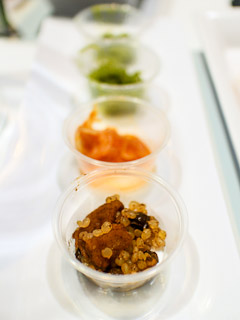 I prepared a bag of the Miracle Noodle with miso soup the other day and I have to admit that when opening the bag and rinsing it out according to the directions, the noodles did retain a slight fishy smell. I suppose that is easily masked by whatever sauce one chooses to serve it with. Aside from traditional noodles, the company also makes "pasta" such as angel hair, fettuccini, and ziti. I tried a few "Italian" sauced samples at their booth and for the discerning pasta lover, this noodle is definitely not a great replacement option. But if you want something that takes less than half the time to get your favorite cavatappi to its proper al dente form or want to save a few calories, Miracle Noodle is a good option. You can get it on their website and at many specialty food stores but you can also get the original Japanese versions at Asian grocery stores.
I prepared a bag of the Miracle Noodle with miso soup the other day and I have to admit that when opening the bag and rinsing it out according to the directions, the noodles did retain a slight fishy smell. I suppose that is easily masked by whatever sauce one chooses to serve it with. Aside from traditional noodles, the company also makes "pasta" such as angel hair, fettuccini, and ziti. I tried a few "Italian" sauced samples at their booth and for the discerning pasta lover, this noodle is definitely not a great replacement option. But if you want something that takes less than half the time to get your favorite cavatappi to its proper al dente form or want to save a few calories, Miracle Noodle is a good option. You can get it on their website and at many specialty food stores but you can also get the original Japanese versions at Asian grocery stores.I found Another Asian import repackaged for American consumers in Caffe Borsa's Hand Drip Premium Coffee. To drink this "fancy" instant coffee that comes in individual packets, you tear off the top to reveal the coffee grounds, hook the clips onto the side of your mug and pour boiling water into the filter or Drip Bag, which the company has trademarked). Better yet, it's compostable. Once I opened the packaging, I realized that the contraption looked exactly like the ones I got from Taiwan a few years ago, just more expensive! Right now, you can get a box of 8 for $8.30 as an add-on item on Amazon. Still, for what it is, the coffee is solid and it's really convenient when you run out of Nespresso capsules at home. The company told me they were targeting hotels, which makes sense, so don't be surprised if you see this at a Holiday Inn in the near future (though probably not at a Four Seasons).
 When I think of marzipan, what generally comes to mind are colorful but not very edible or tasty candies in cute shapes and figures. Nuttyness, a new San Francisco Bay area based company, seeks to change that by introducing American consumers to a high quality chocolate-covered marzipan candy. I am not the biggest fan of marzipan but adding chocolate to it definitely makes me want to eat it more. Nuttyness comes in many different flavors, including an interesting orange cayenne concoction that is likely more of an acquired taste.
When I think of marzipan, what generally comes to mind are colorful but not very edible or tasty candies in cute shapes and figures. Nuttyness, a new San Francisco Bay area based company, seeks to change that by introducing American consumers to a high quality chocolate-covered marzipan candy. I am not the biggest fan of marzipan but adding chocolate to it definitely makes me want to eat it more. Nuttyness comes in many different flavors, including an interesting orange cayenne concoction that is likely more of an acquired taste. 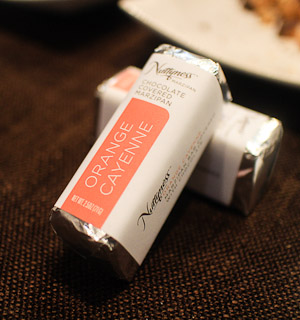 I have to confess that what I like most about Nuttyness is the stylish packaging. The individually wrapped flavors look like refined and tasty European chocolates.
I have to confess that what I like most about Nuttyness is the stylish packaging. The individually wrapped flavors look like refined and tasty European chocolates. Related Articles
Therefore, I could not resist sampling many of the different soft drinks or seltzer waters available at the show. Most of these companies not only made a sparkling beverage but also still versions and often bottled teas. The flavors tend to be aligned with the foodie community's current affinity for spice and herbs, such as lavender and mint. Many are priced in the $3/bottle range and found in your specialty food stores as well many Whole Foods or Cost Plus World Markets.
Herbal Water, from Pennsylvania, makes a sparkling beverage that is zero calories, organic, and containing no artificial flavors or preservatives in flavors such as lemongrass mint vanilla and ginger lemon peel. I don't think the flavors were so prevalent that I could easily distinguish the vanilla AND the lemongrass AND the mint but I do admit that it was much better tasting than the average flavored sparkling water you may find in your national-chain daily supermarket.
Silk Road Soda, founded in March 2013 in northern California, has beverages that are all mint-based in what the company describes as a "Mediterranean style" nonalcoholic beverage. Oh and of course it's all organic and low calorie though I haven't figured out what "low" means after forgetting to ask at the booth. I really liked the pomegranate with mint and I think the mint flavoring gives all beverages that extra refreshing taste.
Spindrift (which I keep wanting to call "spendthrift") was definitely a familiar label to me though I had never actually tried it before. They make seltzer and soda and opened a branch of the company in California in 2010 just to launch their soda line. I liked the soda but given how saturated this category is becoming, I am not sure they are all distinct enough from the commonly found Izze sparkling juices.
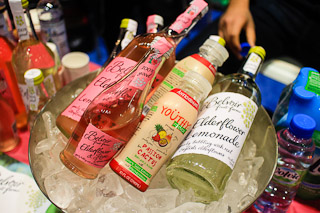 Belvoir Fruit Farms markets to the consumer's sense of class as its founder is a member of the British nobility and its products are produced in the English countryside on a castle estate. It also boasts cordials developed from recipes by said Lord's wife. The sparkling beverages are called pressés and almost all their products come in glass wine-shaped bottles with labels in cursive font. However, a quick search for vendors revealed that you could find Belvoir at WalMart.com. I love elderflower though and they introduced their various elderflower lemonades at the show.
Belvoir Fruit Farms markets to the consumer's sense of class as its founder is a member of the British nobility and its products are produced in the English countryside on a castle estate. It also boasts cordials developed from recipes by said Lord's wife. The sparkling beverages are called pressés and almost all their products come in glass wine-shaped bottles with labels in cursive font. However, a quick search for vendors revealed that you could find Belvoir at WalMart.com. I love elderflower though and they introduced their various elderflower lemonades at the show. Fans of the Vietnamese sparkling limeade that you order while you're eating your bowl of pho (that is, if you aren't drinking Vietnamese ice coffee like me) will love to see a canned version they can pick up in stores. Plus, Phancy Soda Chanh contains no corn syrup, caffeine, preservatives and gluten. It basically tasted like a tangier and healthier Sprite to me but that's not a bad thing.
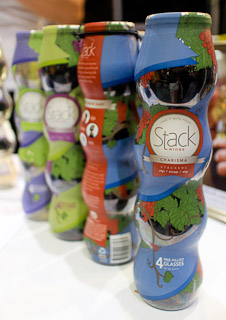 In the alcoholic category, Stack Wines really made an impression, mainly for the convenience of its packaging. These are not quite as charming as the Sofia (Coppola) blanc de blanc pink cans with a straw, but they are still quite clever - the wine is portioned into four individual plastic cups and stacked on top of each other. Each "stack" is the equivalent of a regular bottle of wine. Each cup also has its own plastic cap so you can easily drink it later if you don't finish it all at once. I tested one to make sure that the cap fit tightly enough that it wouldn't easily spill so now I rest assured that I can take it with me on the golf course. I imagine these would also be great for picnics or any other outing where you may lack for something to drink out of and want to decrease your chance of glass breakage.
In the alcoholic category, Stack Wines really made an impression, mainly for the convenience of its packaging. These are not quite as charming as the Sofia (Coppola) blanc de blanc pink cans with a straw, but they are still quite clever - the wine is portioned into four individual plastic cups and stacked on top of each other. Each "stack" is the equivalent of a regular bottle of wine. Each cup also has its own plastic cap so you can easily drink it later if you don't finish it all at once. I tested one to make sure that the cap fit tightly enough that it wouldn't easily spill so now I rest assured that I can take it with me on the golf course. I imagine these would also be great for picnics or any other outing where you may lack for something to drink out of and want to decrease your chance of glass breakage.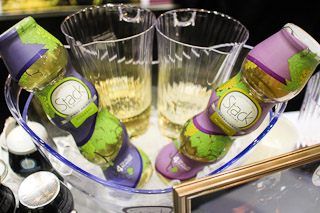 As for the actual wine, you ask? Well, Stack retails in the $9.99-$12.99 range so I would say that the wine tastes about as good as the average $10 bottle you would get at a grocery store. Not exceptional but not bad either. Customers also have four options - chardonnay, pinot grigio, cabernet sauvignon and charisma (a red blend).
As for the actual wine, you ask? Well, Stack retails in the $9.99-$12.99 range so I would say that the wine tastes about as good as the average $10 bottle you would get at a grocery store. Not exceptional but not bad either. Customers also have four options - chardonnay, pinot grigio, cabernet sauvignon and charisma (a red blend).Related Articles
